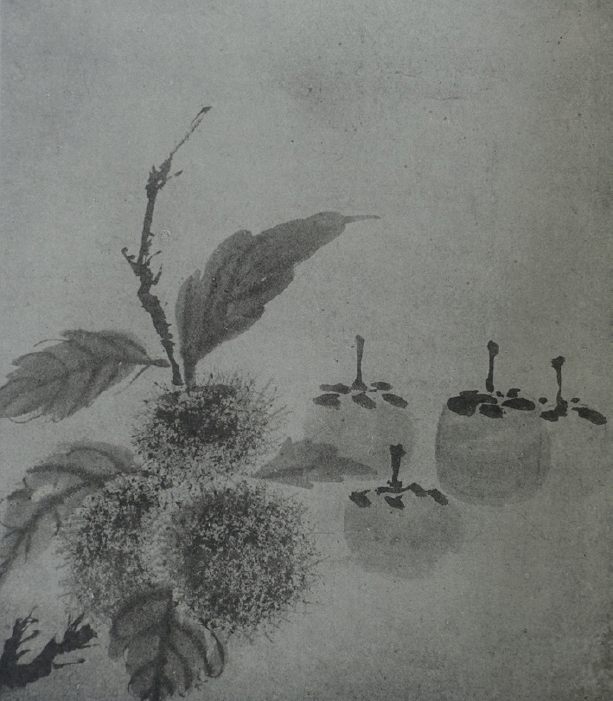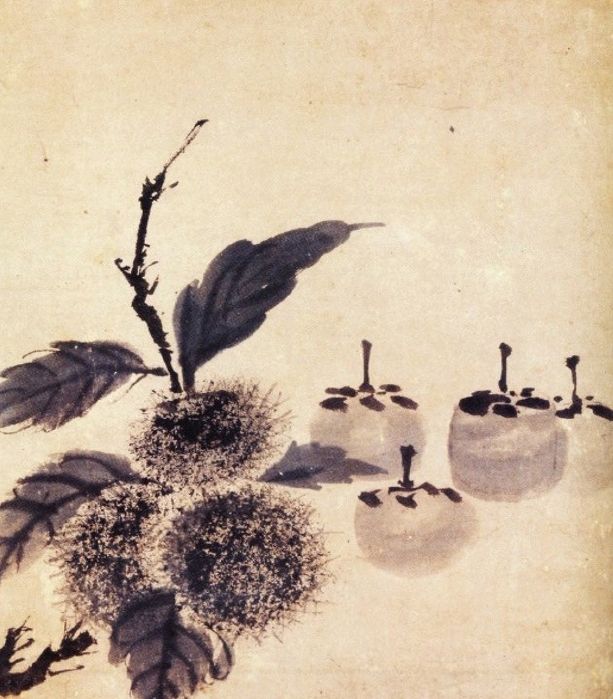松屋久政, 『久政茶會記』.
李日華, 『六研齋三筆』 卷三.
津田宗及, 『宗及茶湯日記自會期』.
__, 『宗及茶湯日記他會期』.
彭蘊璨, 『歷代畵史彙傳』.
강희연, 「牧谿繪畵 受容樣相 硏究: <觀音猿鶴圖>와 <栗枾圖>를 中心으로」, 서울대학교 인문대학원 고고미술사학과, 2019.
강희정, 「 『진미대관(眞美大觀)』과 일본 고대 불교조각」, 『미술사논단』 28, 2009.
고연희 외 6인, 『명화의 탄생 대가의 발견: 한국회화사를 돌아보다』, 아트북스, 2021.
김용철, 「오카쿠라 덴신(岡倉天心)과 일본미술사의 성립」, 『일본사상』 7, 2004.
리처드 반하트 외 4인, 『중국회화사 삼천년』, 정형민 옮김, 학고재, 1999.
이정은, 「아시카가의 문화적 권위와 『군다이칸소초키(君臺観左右帳記)』 제작의 경제적 의미」, 『미술사학』 36, 2018.
장진성, 「명작의 신화-金正喜 筆 〈歲寒圖〉의 성격」, 전국역사학대회발표문, 2011.
__, 「사무라이, 다도(茶道), 선불교-서양인이 본 일본의 미」, 아시아 미 탐험대, 『밖에서 본 아시아, 美: 여행 사진 미술 영화 디자인』, 서해문집, 2020.
조규희, 「만들어진 명작: 신사임당과 초충도(草蟲圖)」, 『미술사와 시각문화』 12, 2013.
岡倉天心, 「東洋の理想」, 『岡倉天心全集』 1, 東京: 平凡社, 1980.
谷信一, 「牧谿畵誌ー中世に於ける支那畵の鑑賞の一節」, 『美術硏究』 43, 1935.
谷晃, 「研究資料: 茶会記に現れた絵画」, 『美術研究』 362, 1995.
國立故宮中央博物院 編, 『故宮書畵錄 增訂本二』 卷四, 臺北: 國立故宮中央博物院中華叢書委員會, 1955.
國華社 編, 「龍光院の傳牧谿栗柿圖解」, 『國華』 493, 1931.
金原省吾, 『東洋美術文庫』 第三卷: 牧谿, 東京: アトリエ社, 1939.
文部省 編, 『日本國寶全集』 25, 東京: 日本國寶全集刊行會, 1927.
相見香雨, 『群芳清玩』 2, 東京: 藝海社, 1913.
星野錫 編, 『東洋美術家寶集』 第一輯 上, 東京: 畵報社, 1912.
小川裕充, 「中国画家牧谿」, 五島美術館 編, 『牧谿: 憧憬の水墨画』, 東京: 五島美術館, 1996.
鈴木敬, 『中国絵画史』 中之一 南宋·遼·金, 東京: 吉川弘文館, 1984.
熊倉功夫, 「江月宗玩と茶の湯」, 田中敦子 編, 『大徳寺龍光院: 国宝曜変天目と破草鞋』, 京都: MIHO MUSEUM, 2019.
熊倉功夫 編, 『利休大事典』, 東京: 学習研究社, 1983.
田島志一 編, 『眞美大觀』 1, 東京: 日本佛敎眞美協會, 1899.
佐藤道信, 『明治国家と近代美術ー美の政治学』, 東京: 吉川弘文館, 1999.
佐賀東周, 「六通寺派の画家」, 『支那学』 1, 1920.
竹內順一, 「茶会記における牧谿画」, 五島美術館 編, 『牧谿: 憧憬の水墨画』, 東京: 五島美術館, 1996.
持井康孝, 「エルンスト·グロッセ: その家族及び東亞古美術調査収集行簡介」, 『金沢大学文学部論集 史学考古学地理学編』 20, 2000.
千宗室 編, 『茶道古典全集』, 京都: 淡交社, 1977.
筒井紘一, 「茶の湯の菓子ーその成立と展開」, 筒井紘一 編, 『茶道学大系』 4 懐石と菓子, 京都: 淡交社, 1999.
戸田禎佑 編, 『水墨美術大系』 3 牧谿·玉澗, 東京: 講談社, 1973.
Cahill, James.Chinese Painting. Geneva: Skira, 1960.
__. “Continuations of Ch’an Ink Painting into Ming-Ch’ing and the Prevalence of Type Images.” Archives of Asian Art 50 (1997/1998): 17-41.
Grosse, Ernst.Die Ostasiatische Tuschmalerei. Berlin: B. Cassirer, 1922.
Kümmel, Otto.Die Kunst Ostasiens. Berlin: B. Cassirer, 1921.
Levine, Gregory P. A. “Critical Zen Art History.” Journal of Art Historiography 15 (2016): 1-30.
Moxey, Keith. “Motivating History.”The Art Bulletin 77 (1995): 392-401.
Okakura Tenshin.Collected English Writings 2. Tokyo: Heibonsha Limited, Publishers, 1984.
__.Collected English Writings 3. Tokyo: Heibonsha Limited, Publishers, 1984.
Rath, Eric. Food and Fantasy in Early Modern Japan. Berkeley: University of California Press, 2010.
Seckel, Dietrich. “Mu-hsi: Sechs Kaki-Früchte. Interpretation eines Zen-Bildes.” Nachrichten der Gesellschaft für Natur- und Völkerkunde Ostasiens 77 (1955): 44-55.
Seo, Audrey Yoshiko. Ensō: Zen Circles of Enlightenment. Boston: Weatherhill, 2007.
Sickman, Laurence and Alexander Soper. The Art and Architecture of China. Harmondsworth: Penguin Books, 1955.
Swann, Peter S.Chinese Paintings. New York: Universe Books, Inc., 1958.
Waley, Arthur. Zen Buddhism and Its Relation to Art. London: Luzac, 1922.
__. An Introduction to the Study of Chinese Painting. New York: Grove Press, 1923.
Wey, Nancy. “Mu-ch’i and Zen Painting.” PhD diss., The University of Chicago, 1974.
Wu, Xiaojin. “Metamorphosis of Form and Meaning: Ink Bird-and-Flower Screens in Muromachi Japan.” PhD diss., Princeton University, 2011.
Li Rihua. Liu yan zhai san bi.
Matsuya Hisamasa.Hisamasa chakaiki.
Peng Yuncan. Li dai Hua shi hui zhuan.
Tsuda Sōgyū. Sōgyū takaiki.
__. Sōgyū jikaiki.
Chang, jinsŏng (Chang, Chin-Sung). “Myŏngjak ŭi shinhwa kimjŏnghŭi p'il sehando ŭi sŏnggyŏk [The Myth of Masterpieces: Kim Jŏnghŭi’s Sehando].” Chŏn'guk yŏksahak taehoe palp'yomun [Statements of the National Conference on Historical Studies], 2011.
__. “Samurai tado sŏnbulgyo sŏyangin i pon ilbon ŭi mi [Samurai, Tea Ceremony, and Zen Buddhism: Japanese Beauty through Western Eyes].” In Pakkesŏ pon ashia mi [Asia through Foreign Eyes, Beauty], edited by Ashia mi t'amhŏmdae, 86-121. Sŏul: Sŏhae munjip, 2019.
Cho, Gyuhŭi (Cho, Kyuhee). “Mandŭrŏjin myŏngjak shinsaimdang gwa ch'och'ungdo [The Invention of the Canon: Sinsaimdang and Insects and Plants].” Misulsa wa shigangmunhwa [Art History and Visual Culture] 12 (2013): 58-91.
I, Chŏngŭn (Lee, Jungeun). “Ashik'aga ŭi munhwajŏk kwŏnwi wa kundaik'ansoch'ok'i chejak ŭi kyŏngjejŏk ŭimi [Commodity, Cultural Authority, and Kundaikan sōchōki].” Misulsahak [Art History] 36 (2018): 217-246.
Kang, Hŭijŏng (Kang, Heejung). “Chinmidaegwan gwa ilbon kodae pulgyo chogak [The Selected Relics of Japanese Art and the Ancient Buddhist Sculpture in Japan].” Misulsa nondan [Art History Forum] 28 (2009): 89-110.
Kang, Hŭiyŏn (Kang, Heeyeun). “Mokgye hoehwa suyong yangsang yeongu [A Study of the Reception of Muqi’s Paintings].” Sŏul taehakkyo sŏksa hagwi nonmun, 2019.
Kim, Yongch'ŏl (Kim, Yongcheol). “Ok'ak'ura tenshin gwa ilbon misulsa ŭi sŏngnim [Okakura Tenshin and the Establishment of Japense Art History].” Ilbon sasang [ Japanese Philosophy] 7 (2004): 177-197.
Ko, Yŏnhŭi (Ko, Yeon-Hee) oe yugin.Myŏnghwa ŭi t'ansaeng taega ŭi palgyŏn [Birth of Masterpiece, Discovery of Master]. P’aju: At'ŭbuksŭ, 2021.
Rich'ŏdŭ Panhat'ŭ oe sain.Chungguk hoehwasa samch'ŏnnyŏn [Three Thousand Years of Chinese Painting]. Chŏng hyŏngmin Omkim. Sŏul: Hakkojae, 1999.
Aimi Kōu.Gunpō seigan [Appreciation of Fragrant Flowers]. Tokyo: Geikaisha, 1913.
Guo li gu gong zhong yang bo wu yuan, ed. Gu gong shu hua lu zeng ding ben er [Records of National Palaces Museum’s Calligraphies and Paintings, Revised and Enlarged Edition Two] 4. Taipei: Guo li gu gong zhong yang bo wu yuan zhong hua cong shu wei yuan hui, 1955.
Hoshino Shaku, ed.Tōyō bijutsu kahōshū [Asian Art Heirloom]. Tokyo: Gahōsha, 1912.
Kinbara Seigo.Tōyō bijutsu bunko 3:Mokkei [Asian Art Library: Muqi]. Tokyo: Atorisesha, 1939.
Kokkasha, ed. “Ryōkō-in no den Mokkei Kakikurizu [Ryōkō-in Temple’s Persimmons and Chestnuts attributed to Muqi].”Kokka [Flower of the Nation] 493 (1931): 351.
Kumakura Isao et al., ed. Rikyū daijiten [Rikyū Unabridged Dictionary]. Tokyo: Gakushū Kenkyūsha, 1989.
Kumakura Isao. “Kōgetsu Sōgan to chanoyu [Kōgestu Sōgan and Tea Ceremony].” In Daitoku-ji ryōkōin: kokuhō yōhentenmoku to hasōai [Living in Zen and the Daitoku-ji Ryōkōin Heritage], edited by Tanaka Atsuko, 148-160. Shiga: MIHO MUSEUM, 2019.
Monbushō, ed. Nihon kokuhō zenshū [Complete Collection of National Treasures of Japan] 25. Tokyo: Nihon kokuhō zenshū kankōkai, 1927.
Ogawa Hiromitsu. “Chūgoku gaka Mokkei [Chinese Painter Muqi].” In Mokkei: Shōkei no suibokuga [Ink Mists: Zen Paintings by Muqi], edited by Gotō Bijutsukan, 91-101. Tokyo: Gotō Bijutsukan, 1996.
Okakura Kakuzō.Okakura Tenshin zenshū [Complete Works of Okakura Tenshin] 1. Tokyo: Heibonsha, 1980.
Saga Tōshū. “Likutsūjiha no gaka [Painters of Liutong-si school].” Shinagaku [Sinology] 1 (1920): 31-49.
Satō Dōshin. Meiji kokka to kindai bijutsu: Bi no seijigaku [Meiji Country and Modern Art: Politics of Beauty]. Tokyo: Yoshikawa Kōbunkan, 1999.
Sen Sōshitsu, ed. Chadō kōten zenshū [Complete Works of Classics in the Way of Tea] 1-12. Kyoto: Tankōsha, 1977.
Suzuki Kei. Chūgoku kaigashi chū no ichi: Nansō, Ryō, Kin [Chinese Painting History: Southern Song, Liao, Jin]. Tokyo: Yoshikawa Kōbunkan, 1984.
Tajima Shiichi, ed. Shinbi taikan [Selected Relics of Japanese Art] 1. Tokyo: Nihon bukkyō shinbi kyōkai, 1899.
Takeuchi Junichi. “Chakaiki ni okeru mokkeiga [Muqi’s Paintings in Records of Tea Gatherings].” In Mokkei: Shōkei no suibokuga [Ink Mists: Zen Paintings by Muqi], edited by Gotō Bijutsukan, 160-169. Tokyo: Gotō Bijutsukan, 1996.
Tani Akira. “Kenkyū siryō: chakaiki ni arawareta kaiga [Research Material: Paintings in Records of Tea Gatherings].” Bijutsu kenkyū [Art Study] 362 (1995): 237-263.
Tani Shinichi. “Mokkei gashi: Chūsei ni okeru shinaga no kanshō no issetsu [Records of Muqi’s Paintings: Appreciation of Chinese Paintings in Medieval Ages].” Bijutsu kenkyū [Art Study] 43 (1935): 1-11.
Toda Teisuke, ed. Suiboku bijutsu taikei [Outline of Monochrom Ink Painting History] 3. Tokyo: Kōdansha, 1973.
Tsutsui Hiroichi. “Chanoyu no kashi: Sono seiritsu to tenkai [Confectionery of the Way of Tea’s Establishment and Development].” In Chadōgaku taikei 4: Kaiseki to kasha [Outline of Tea Ceremony Studies 4: Kaiseki and Desserts], edited by Tsutsui Hiroichi, 290-318. Kyoto: Tankōsha, 1999.
Yasutaka Mochii. “Erunesuto Gurosse: sono kazoku oyobi tōa kobijutsu chōsa shūshūkō kankai [Ernst Grosse: His Family and His Tour to East Asia in the Capacity of Art Collector].” Kanazawa daigaku bungakubu ronshū shigaku kōkogaku chirigaku [Kanazawa University Literature Department Dissertations: History, Archaeology, and Geology] 20 (2000): 33-72.
Cahill, James.Chinese Painting. Geneva: Skira, 1960.
__. “Continuations of Ch’an Ink Painting into Ming-Ch’ing and the Prevalence of Type Images.” Archives of Asian Art 50 (1997/1998): 17-41.
Grosse, Ernst.Die Ostasiatische Tuschmalerei. Berlin: B. Cassirer, 1922.
Kümmel, Otto.Die Kunst Ostasiens. Berlin: B. Cassirer, 1921.
Levine, Gregory P. A. “Critical Zen Art History.” Journal of Art Historiography 15 (2016): 1-30.
Moxey, Keith. “Motivating History.”The Art Bulletin 77 (1995): 392-401.
Okakura Tenshin.Collected English Writings 2. Tokyo: Heibonsha Limited, Publishers, 1984.
__.Collected English Writings 3. Tokyo: Heibonsha Limited, Publishers, 1984.
Rath, Eric. Food and Fantasy in Early Modern Japan. Berkeley: University of California Press, 2010.
Seckel, Dietrich. “Mu-hsi: Sechs Kaki-Früchte. Interpretation eines Zen-Bildes.” Nachrichten der Gesellschaft für Natur- und Völkerkunde Ostasiens 77 (1955): 44-55.
Seo, Audrey Yoshiko. Ensō: Zen Circles of Enlightenment. Boston: Weatherhill, 2007.
Sickman, Laurence and Alexander Soper. The Art and Architecture of China. Harmondsworth: Penguin Books, 1955.
Swann, Peter S.Chinese Paintings. New York: Universe Books, Inc., 1958.
Waley, Arthur. Zen Buddhism and Its Relation to Art. London: Luzac, 1922.
__. An Introduction to the Study of Chinese Painting. New York: Grove Press, 1923.
Wey, Nancy. “Mu-ch’i and Zen Painting.” PhD diss., The University of Chicago, 1974.
Wu, Xiaojin. “Metamorphosis of Form and Meaning: Ink Bird-and-Flower Screens in Muromachi Japan.” PhD diss., Princeton University, 2011.


























